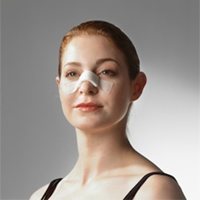Deviated Septums Can Be Corrected with Septoplasty
 Inside your nose is a set of cartilage and bone pieces that dictate the shape and function of your nose. One of the largest pieces of cartilage is the septum, which is located in the center of your nose and divides it into two halves. When your septum is whole and straight, it also keeps your nose stable and ensures that air moves the nasal passages unimpeded. However, if your septum becomes deviated, your nose can be seriously affected. It can look crooked or dented on the outside, plus it can cause breathing problems that could affect your overall health. Septoplasty, a subtype of rhinoplasty, can repair a deviated septum so that your nose looks and functions normally.
Inside your nose is a set of cartilage and bone pieces that dictate the shape and function of your nose. One of the largest pieces of cartilage is the septum, which is located in the center of your nose and divides it into two halves. When your septum is whole and straight, it also keeps your nose stable and ensures that air moves the nasal passages unimpeded. However, if your septum becomes deviated, your nose can be seriously affected. It can look crooked or dented on the outside, plus it can cause breathing problems that could affect your overall health. Septoplasty, a subtype of rhinoplasty, can repair a deviated septum so that your nose looks and functions normally.
How Does a Deviated Septum Occur?
For most people, a deviated septum occurs as a result of trauma. A blow to the nose during a fall, accident, sporting event, or physical abuse can bend, crack, or break the septum. Ideally, you should have a broken nose set as soon as possible after it occurs; this doesn’t always happen, however. Sometimes even when a nose is set after a break, it can be done improperly. This creates a deviated septum.
There are a small number of people who naturally have deviated septums, either through genetics or weak cartilage that is more susceptible to breaks. An even smaller group of people have a deviated septum as a result of a previous rhinoplasty. This can occur when the surgery isn’t done properly, or if the patient neglects to follow their instructions for rhinoplasty recovery.
Why Does Having a Deviated Septum Cause Health Problems?
Since the septum’s natural function is regulate how air moves in and out of your nose, the most obvious and most common consequence of a deviated septum that your breathing becomes more limited. The degree to which your breathing is limited depends on the severity of the deviation; some patients have only a funny breathing sound while others can only breathe out of one side of their nose. Other issues experienced by people with deviated septums include sinus infections and congestion or frequent nosebleeds.
If you’re having trouble breathing, you’ll naturally start limiting the amount of activity you do. Running around and playing sports becomes even harder and a little scary when you can’t breathe properly. Less physical activity can cause you to gain weight and even lead to obesity.
A more serious condition that can develop from difficulty breathing is sleep apnea. People with sleep apnea have a tendency to stop breathing in their sleep, depriving your brain and body of oxygen and preventing you from getting a full night’s rest.
What Does Septoplasty Do to Fix This Problem?
Septoplasty is a subtype of functional rhinoplasty, a nose reshaping surgery that improves the overall function of the nose. Septoplasty specifically focuses on the septum to repair and straighten it out. It can be done as part of other corrections or improvements to your nose, or it can be done as an individual procedure.
Septoplasty can be performed externally or internally based on the amount of necessary repairs. With an external septoplasty, the surgeon makes small incisions on the outside of the nostrils and then lifts the soft tissue away to gain access to the internal cartilage and bone. This method is used most often and generally on more severely deviations. An internal septoplasty is usually used for septums that only require minor repairs and involves accessing the cartilage from the inside of the nostrils with no external incisions.
Once the surgeon has access to the septum, he can make repairs by removing broken pieces of cartilage and repositioning what’s left over. Sometimes, the damage is so extensive that a cartilage graft has to be used to rebuild the septum. The graft typically comes from the patient’s ear, but it can also be harvested from a rib. In the event that a patient’s cartilage is too weak to create a stable septum, a surgeon can use synthetic implants to create a brand new septum.
Once the septum has been repaired and repositioned, the surgeon closes the incisions and then sets your nose in a splint to prevent your septum from getting crooked again. Your total recovery time will depend on the extent of the damage to your septum before the surgery, but generally speaking, patients are able to have the splints and sutures removed and resume normal activities after one to two weeks.
Septoplasty with Dr. Shapiro
Dr. Daniel Shapiro performs septoplasty and other types of rhinoplasty at his state-of-the-art facility in Scottsdale, AZ. He is also a board-certified surgeon who has been working with patients and their noses for almost twenty years. To schedule a septoplasty consultation with Dr. Shapiro, call (480) 451-1700 today.


